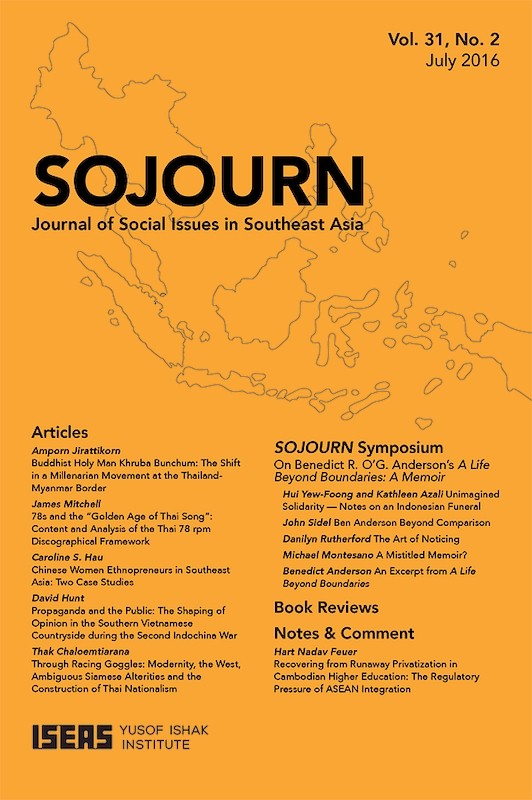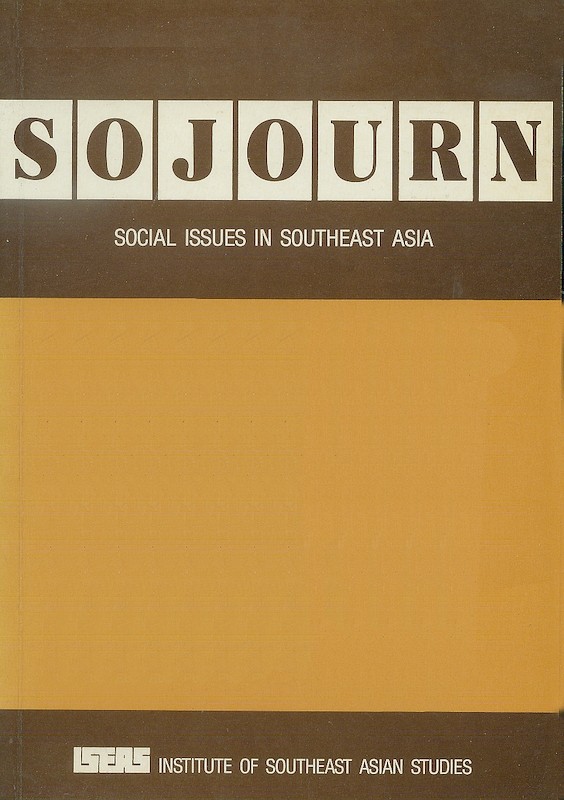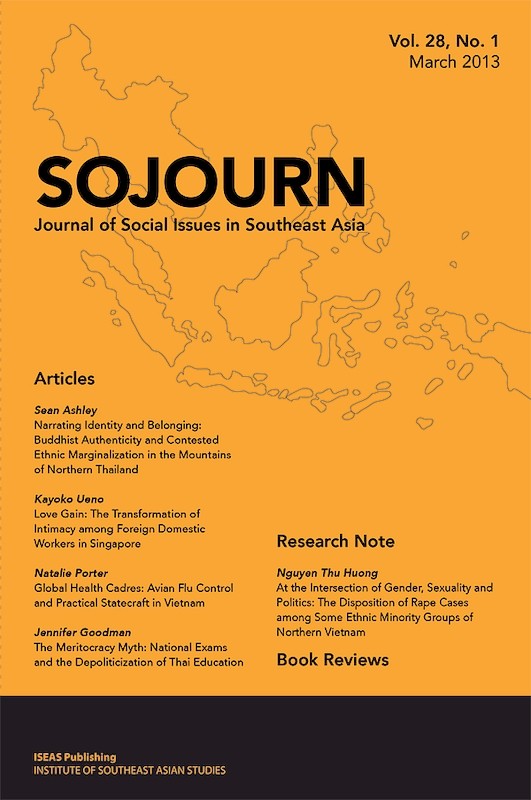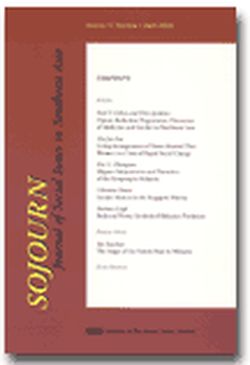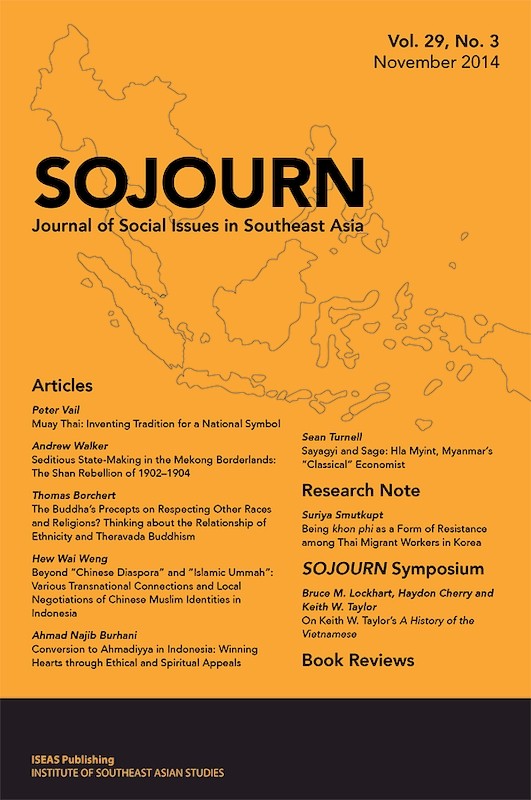SOJOURN: Journal of Social Issues in Southeast Asia Vol. 3/2 (Aug 1988)

Date of publication:
August 1988
Publisher:
Institute of Southeast Asian Studies
Number of pages:
151
Code:
SJ3/2
Contents
-
Preliminary pages
- ARTICLES
-
The Indonesian Mentality and Development, by Koentjaraningrat, author see abstractDevelopment has been, and continues to be, an issue of pressing concern in post-independence Indonesia. In the 1960s particularly, considerable attention was given to how development could be achieved and whether or not features of the indigenous cultures of Indonesia were compatible with the development process. This essay (originally published in Indonesian in 1969) examines this issue in terms of "mental characteristics" and "cultural values", reflecting the concerns of this period from an anthropological perspective. The essay was incorporated as part of a research design for a national study carried out under the sponsorship of the Indonesian Institute for Sciences (Lembaga Ilmu Pengetahuan Indonesia, LIPI) to obtain a better understanding of the problem, namely to what extent the mental attitudes of particular categories of the Indonesian population are conducive for economic development which was initiated with the First Five-Year Development Plan (Repelita I) in 1969. The results of the study, which was submitted to the National Bureau of Planning (BAPPENAS) in 1972-74, have never been published. However, the study has been used extensively as background material in the Second Five-Year Development Plan (Repelita II) and other subsequent plans.
-
The Hupphaasawan Movement: Millenarian Buddhism among the Thai Political Elite, by Peter A Jackson, author see abstractBuddhist millenarian movements previously described in Thailand have been associated with peasant rebellions against central Thai authority. However, the Hupphaasawan movement, formed by the spirit medium Suchaat Kosonkittiwong in the 1970s, differed from this pattern in that it attracted followers from among the most senior and powerful sections of the Thai political establishment. The Hupphaasawan movement nevertheless did share many features in common with earlier millenarian movements and demonstrated the continuing potential for the development of millenarian religious movements in Thailand. Key factors identified as contributing to the development of millenarian movements in Thailand are a high degree of political frustration; lack of access to institutional expressions of power; attachment to traditional spiritualist beliefs; and a heightened sense of political, economic, or cultural threat.
-
Population Change in Burma: A Comparison of the 1973 and 1983 Censuses, by Mya Than, Subbiah Gunasekaran, authors see abstractA comparison of the 1973 and 1983 censuses provides ample evidence of a decline in fertility in Burma. The proportion of children in the population fell substantially in the ten-year period accompanied by a significant increase in the mean age at marriage as indicated by the higher female singulate mean age at marriage. An analysis of the regional variations in population density indicates inter-regional movement of population. While there is marked success in the literacy programmes as indicated by the sharp reduction in the prevalence of illiteracy, especially among the females, changes in the industrial and occupational structure of the labour force suggest worsening economic conditions. Under these circumstances, it is surmised that the fall in fertility, without any concerted government policy for inducing such a decline, may be a first-level and benign response of a more literate and hence more informed population to rising aspirations and the inability of the economy to accommodate these aspirations.
-
A New Generation: Missionary Education and Changes in Women's Roles in Traditional Northern Thai Society, by Hebert R Swanson, author see abstractNineteenth-century American Presbyterian missionaries introduced new women's roles into northern Thai society through their churches and institutions. While appreciating northern Thai women's social freedom, the missionaries, influenced by an ideal of "true womanhood", found women's low religious status in Buddhism and lack of educational opportunities repugnant. They sought to change women's roles by educating convert women, thus creating the first corps of women professionals in northern Siam. The missionaries unintentionally secularized education and thereby expanded the social roles available to northern Thai women. In doing so, they repeated in northern Siam a pattern of the Protestant role in social change and secularization common in American social history.
- RESEARCH NOTES AND COMMENTS
-
Sambran (The White Python): The Kha (Lao Theung) Revolt of 1936-39, by Geoffrey Gunn, author see abstractThe revolt of the shaman, Sambran, and his montagnard followers of a "Python God" which spread from the Vietnamese highlands of Annam to southern Laos in the late 1930s is discussed in the context of proto-nationalist responses to the intervention of outside powers. It is argued that despite their apparent millenarian character and abject failure, such movements are important reminders of the political nature of the native resistance against colonial powers.
-
Women in Health Development: Mobilization of Women for Health Care Delivery in a Philippine Community, by Trinidad Osteria, Pilar Ramos-Jimenez, authors see abstractA participatory-action research project in health was conducted in a tribal community in the Philippines to demonstrate the feasibility and effectiveness of implementing a village-based health care delivery system through simple training, the use of indigenous resources, and active community involvement in health planning. The project was divided into three phases: an initial phase of baseline information gathering to determine the existing health situation, the health resources available, and the health-seeking behaviour and beliefs concerning illness; a second phase of programme formulation and implementation; and a third phase of assessment and evaluation. The baseline information collected served as the basis for the planning of a relevant health programme which made use of a culturally appropriate training programme and women volunteers in the community. Activities involved both the preventive and curative aspects of health care. At the end of the project period which lasted fifteen months, an assessment was undertaken using household surveys, as well as an assessment of the skills of the health workers. Lessons and issues derived revolved around the selection of voluntary health workers, community participation, training, incentives and rewards, supervision, and support. On this basis, recommendations were made for the programme's sustainability and replicability.
- BOOK REVIEWS
-
BOOK REVIEW: Modern Thai Literature -- With an Ethnographic Interpretation by Herbert P Philips, in association with Vinita Atmiyanandana Lawler, Amnuaycaj Patipat, and Likhit Dhiravegin., by Ananda Rajah, author
-
BOOK REVIEW: Shelter for the Homeless: Asian-Pacific Needs and Australian Responses. By J D Conroy., by Chua Beng Huat , author
-
Index to SOJOURN: Social Issues in Southeast Asia, vol. 1-3 (1986-88)

